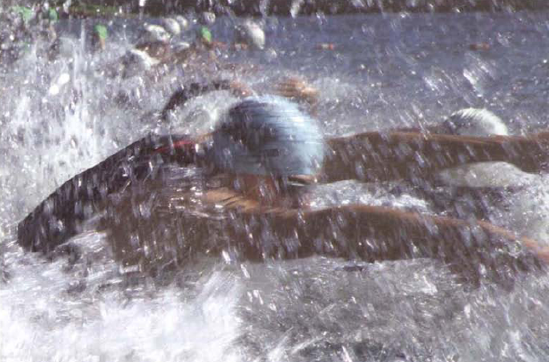For years I've been intrigued by how to reveal movement in still photography. How do you create, for example, the ideal picture of a white-water kayaker, a photo that would need to show ber arms in motion and the action of ber paddle churning round like the blades of a windmill. And how can a single, still photo be made to show the powerful pedaling—and some of the sweat and desperation—of a come-from-behind bicyclist as be races to overtake the leader only twenty feet from the finish line?
In addition to revealing physical movements of the world around us, motion photographers are also challenged to draw out some of the delight, surprise, humor and deeper emotions we all associate with movement. Because humans are intensely emotional creatures and movement is the most intensely perceived of all the external events of our lives, there can be no denying our emotional ties to movement. Whether it's the beart jumping at the sight of a loved one's windblown hair or the brain calculating the trajectory of cars flying through a busy intersection we must cross, movement does indeed move us.
The world of sports is a popular and rich source of movement and emotion for photographers: sports events positively drip with action-friendly adrenalin, an all-natural fuel additive that gives contestants a boost of both speed and determination.
Fortunately, photographers themselves don't need to be on the offensive line or on the back of a bucking bronco to feel swept up in the action. You feel excitement building at a sporting event even as you set up along the sidelines, focus from the bleachers, or scout out the best place from which to pan jumping horses or fast-paced cross country runners. Later as you concentrate on the action and start to take pictures, you find that witnessing these contests of will and impressive feats of strength can dredge up powerful reactions from deep in your mind. Tucked away there are primitive brain circuits that still remember a time when athleticism was a survival tactic; then, competition was equated with hunt or be hunted, fight or flee, and even mate or migrate.
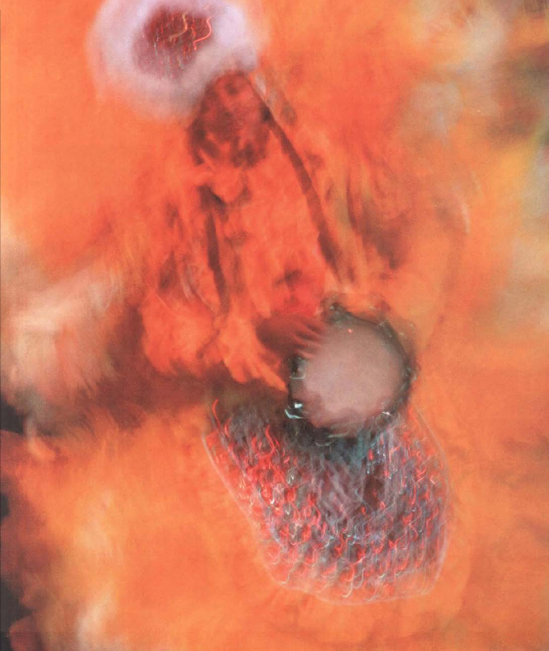
Figure 3.1. Sometimes the shutter speed you choose leads to a blurry impressionistic photo that bean little resemblance to what we normally think a photo should look like. I photographed this shimmying performer with a handheld camera set w a shutter speed of 1/6 second.
Whether a sport you photograph is an individual effort to try to jump the highest, a hand-to-hand combat with fencing foils or fists, or a free-for-all muddle of mud wrestlers, you'll find plenty of opportunities at sporting events to try out your full spectrum of shutter speed settings.
Motion photography, of course, offers you more than just the traditional subjects, clichéd shots, and sometimes extreme emotions of organized sports. Allow yourself to draw emotions from scenes seemingly devoid of them. To some, the soft blur of a curtain blowing around a vase of sunflowers may simply be a windblown piece of cloth; to others, the display of this invisible force of nature can be haunting, perhaps calling back a childhood moment of a warm summer breeze playing through the house.
The camera can reveal motion in ways the eye never sees. Our human perception is that the motion of life is an ongoing and continuous saga—not an instant frozen in time. Your eyes can't perceive fast actions like the split-second of contact when a driver smashes into a golf ball. Thus you may have just seen your dog leap from a dock to get a stick you threw into the lake. But now—only a moment later—you can remember the action but probably not any of the details of what was happening. Without a photo you cannot recall the particulars of the dog's straining muscles, his tongue lolling from the side of his mouth and his ears flopping up. With the photo, telling details enrich the memory of a loyal friend.
Step through the gates of a state, county, or village fair and you slip into a fantasyland of photographic opportunity. Bustling with a wide variety of activities from dawn to dusk (and later), fairs and festivals are wonderful places rich with activities that challenge your motion interpretation skills.

To obtain photos for this book 1 traveled to several sites, including the Crawford County Fair in Pennsylvania, the Wayne County Fair in New York, the New York State Fair in Syracuse, and the Firemen's Festival in East Rochester. Along the way, I encountered hurdle-leaping llamas, proud owners detailing their pigs with hose and scrub brush, strolling musicians strumming guitars, chainsaw artists carving eagles and bears, BMXers launching themselves from ramps and flipping upside
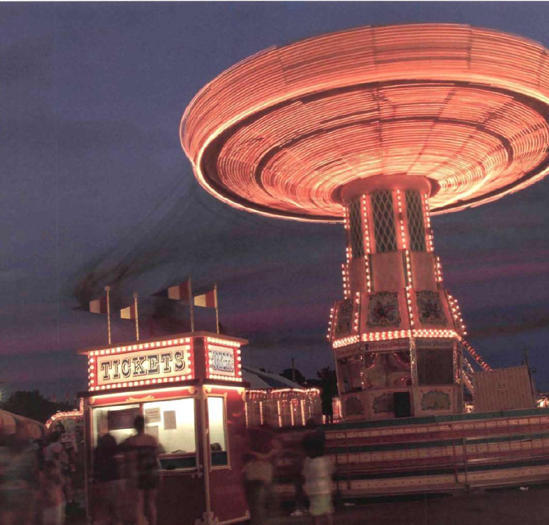
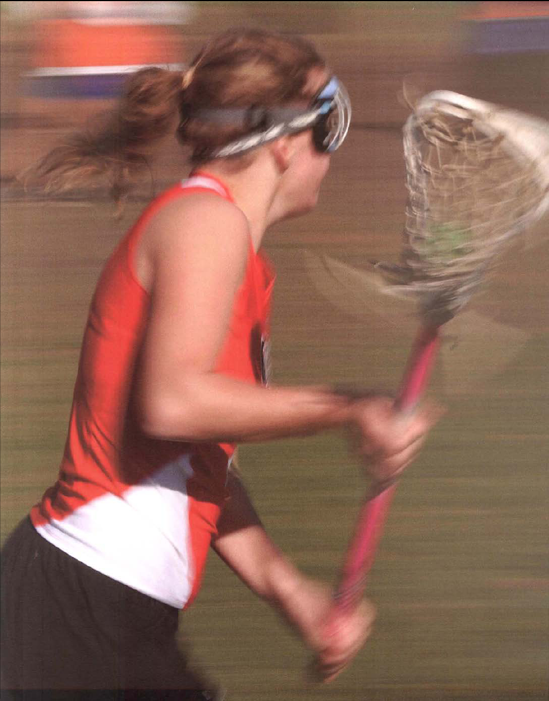
I spied the picture possibilities as soon as I walked into the bedroom: curtains at the open window, fluttering in a light summer breeze. As quickly as I managed to set up the tripod and camera, 1 wasn't fast enough. I learned that summer breezes ate fickle and can't be counted on to waft curtains when you want them to.
I waited and waited for a breeze that never came. Rather than waste more time waiting for a wayward wind, I simulated a breeze by lifting and dropping the curtains. I placed the camera about eight feet from the curtains and set it on the two-second self-timer mode. Then I pressed the shutter release and did a quick three-step shuffle over to the curtains, pulled them up and spread them out like the train of a wedding dress. I then tried to drop them just before the self timer opened the shutter.
Judging by this picture you'd think I was successful. Well 1 was—but that's only because I played the numbers game. Many an out take shows my hand still holding the curtains, or shows the curtains back at test because I'd released them before the shutter opened. Suffice it to say that between my poor timing and the great variability of the appearance of the flopping curtains at different shutter speeds, I spent nearly an hour leaping from camera to curtains and curtains to camera. A remore shutter release would have greatly simplified my task.
Using shutter speeds ranging from 1/15 second to 1 second, 1 eventually found that shutter speeds around 1/4 second pleasingly blurred the moving curtains.
As in most aspects of life, contrast nearly always intensifies an experience. The contrast to motion is immobility. The contrast to white is color. So to contrast with the flopping curtains I chose an immobile but colorful subject—a flower vase. If you decide to try a picture like this, 1 suggest choosing a beavy, well-balanced flower vase. You'll want to avoid the possibility of having to clean up spilled water and shards of broken pottery or beirloom crystal.
Exposure at 1/2 second, f/16.
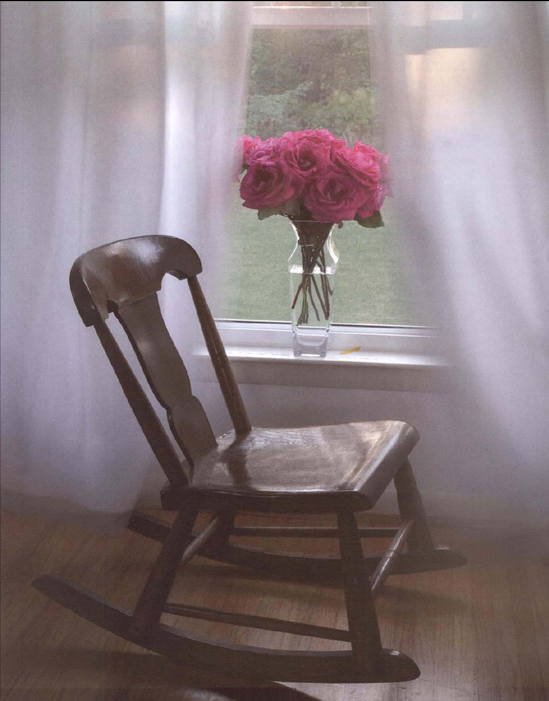
This is a straightforward action shot 1 took for a book I was doing on the Finger Lakes in central New York. The swimmers are leaping into the south end of Cayuga Lake from a beach in Alan Treman State Park just north of Ithaca.
To catch the pandemonium, I decided to photograph the start of the race as the throng of triathletes thrashed into the water. 1 thought this transition from land into the water would reveal the most action, especially with lots of splashing as they first charged into the water, and then again as they reached the deeper water to begin swimming.
To get this picture I moved off to the side of the swimmers and waded into the water up to my knees. Then I stooped down a bit so I'd be more at the level of the swimmers, a move that belps pull viewers into my photograph. My intention was to make viewers feel like they're part of the action—out in the water, close to the pack of swimmers leaping right past their eyes.
Although for sports photography I often prefer blur shots over stop-action exposures, in this case I felt that freezing both the splashes of water and the burst of vigorous movements of athletes just starting the race would best tell the story.
I used a shutter speed of 1/250 second and an aperture of f/11. With the athletes springing into action at different speeds, the setting of 1/250 second shows some of them sharp and others subtly blurred. Maybe it would have been better to use 1/125 second so the blurred areas would have been more obvious, or perhaps 1/2000 second to make everything super sharp. The smaller picture, a crop from the original photo, shows an interesting pattern of water droplets obscuring the swimmer. Maybe next time I photograph similar swimmers, I'll try to replicate that. Studying your pictures often proves to be the best teaching tool.
Exposure at 1/250 second, f/ll.
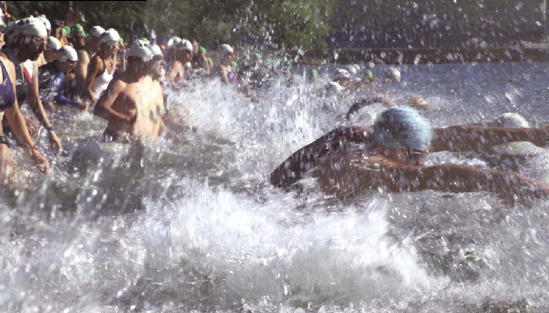
The stunt rider in this picture was part of the entertainment at the New York State Fair. Two sets of ramps confined the action, and having watched the end of an earlier show, I expected that some of the best BMX tricks would occur just above the end of each ramp. Given the modest size of the crowd and informal nature of the sport, it was no problem for me to move into a prime position and get the angle I wanted.
You can use a moderate to slightly slow shutter speed in the range of 1/15 to 1/60 second to reveal the world both still and moving. You do this by intentionally blurring only part of a scene, leaving the rest of the picture area sharp. The part of the picture you choose to blur should be important or significant, because you are using the blur to draw attention.
Does it work? Turn your eyes away from this picture and then quickly look again.
The BMX show lasted nearly half an hour, giving me almost enough time to try my full repertoire of motion techniques. But what 1 really wanted was what 1 got for this discussion: a picture that showed everything sharp except the rider. To show the ramp and the spectators in the grandstand sharp and juxtaposed in contrast to the rider, I had to carefully choose my position.
Exposure at 1/60 second, f/29.

A summer evening and 1 was once again driving around the Finger Lakes in central New York. The West Lake Road runs along the western side of Keuka Lake for most of its 25-mile distance. Cottages bere are bunched together and always filled with vacationers.
As I drove along, out of the corner of my eye I saw a boy drop out of the sky. I slammed on the bmakes and backed up about fifty yards to see what was going on. That's when I saw several dripping wet boys emerge from the lake and run into the open front door of an unfinished cottage. Dashing upstairs to the second floor, they quickly gathered on a balcony that overhung the water below.
Holding onto the balcony railing, one by one they climbed over it, leaned out as they gathered their courage, and then leaped into the sky. I wanted to join them—but instead asked the supervising adult if I could take a few pictures.
For some reason I had a prosumer snapshot camera in hand, which meant I could only get one shot of each boy's leap. The timing had to be perfect. And for this picture it was.
In this picture, be has turned in mid air; be's facing the setting sun and its warmth washes over him. Best of all be assumed a wonderfully graceful posture, with one hand clasped over his nose to block water from entering and the other raised to the sky as if in salute. The shutter speed was 1/500 second.
This is one of my all-time favorite pictures. Perhaps the real perfection of timing was that by pure coincidence I happened along while all this was going on. The more you're out taking pictures, the more such coincidences happen.
Exposure at 1/500 second, f/5.
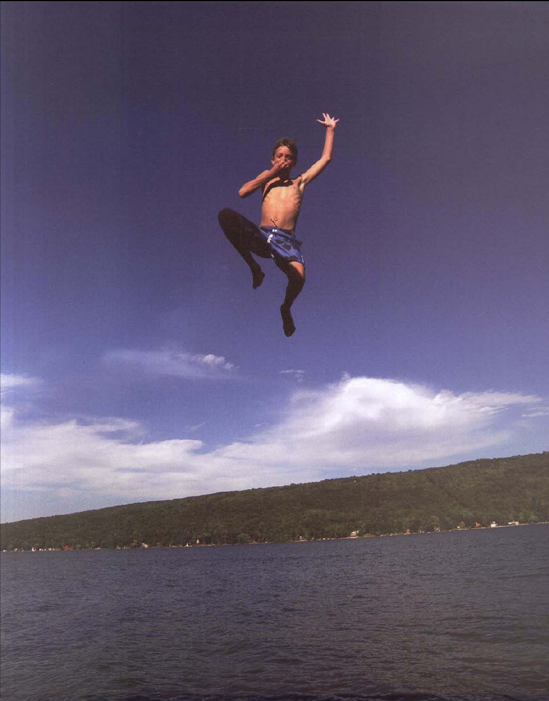
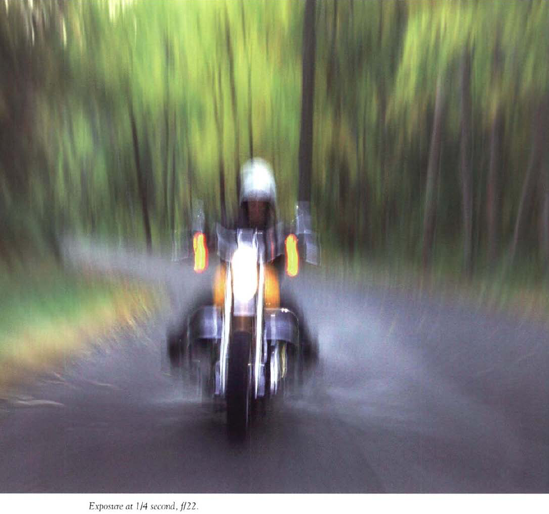
Unlike the spontaneous picture of the boy leaping into the water, this one of the motorcyclist was entirely planned. Twice I had seen a yellow Harley tooling along back roads near the south end of Cayuga Lake. After I saw it the first time, a plan had formed in my mind for a picture. A few weeks later the same Harley passed me again, but going the opposite direction; by the time I'd wheeled my little station wagon around, the Harley had vanished.
It seemed as if I would have to find somebody else with a yellow Harley to participate in my little photo fantasy.
Then fate intervened. (Or is that coincidence working again?) I was visiting my twenty-five-old daughter in Ithaca, New York. She suggested we go to this little ice cream place. We did—and there in the parking lot was the same yellow Harley. As I walked up to the order window, 1 kept my eye open for a guy in motorcycle clothes. And there, finally, belmet in hand, was my road king: dressed in black leathers, eating an ice cream cone and running ber hand through ber long blond hair. Just like in the commercials, my elusive rider was a woman.
My daughter probably wondered what I was up to as, with no word of explanation, I left my place in the ice cream line and walked over to the leather-clad woman. And propositioned ber. It turned out she was a professor, and, of course, my proposition was innocent enough: 1 asked if 1 could photograph ber riding ber Harley along a back road lined with autumn trees.
Now that I had my motorcycle model I needed to enlist a friend with a van. A week later everything was in place: we opened up the van's back door and, as my friend drove, I photographed the yellow Harley following along behind us.
There was one hitch. Those country dirt roads were incredibly bumpy. So—instead of my photos showing a smooth, continuous blur of the road and trees with the motorcyclist revealed fairly sharp—most pictures seemed like they were taken with the camera attached to a jackhammer. But several of the shots I liked, and this is one of them.
What the beck? That's probably what you're wondering when you look at this picture taken on a long, ho-hum, post-vacation drive back home. But, bey, trying out some new shooting techniques to pass the time has to be more fun than playing the license plate game or holding your breath every time you pass a graveyard (I guess knowing those games reveals my age group).
Instead of taking the wheel, I chose to sit in the passenger seat and figure out ways to take pictures while going 65 mph. Now that's real fun.
If you're going to shoot photos from a moving car, choose back roads and secondary roads that pass through small villages and zip by farms. On the 65 mph interstate, you're more limited to subjects like Walmart tractor trailers and then you find yourself daydreaming that you'll somehow take a shot that Walmart will want to pay ten grand for.
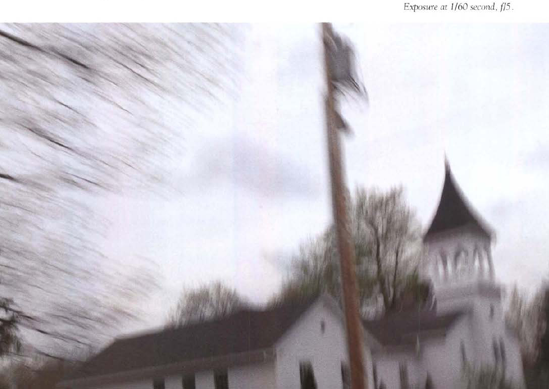
But on the small roads, you pass town halls, a variety of churches with an assortment of steeples, water towers, intersections, barns, bales of hay, horses, and a generally wide mix of visual possibilities.
While returning home from a road trip I tired of admiring the autumn leaves and pulled out my camera. 1 turned off the auto focus and set the focus to infinity, the exposure mode to Shutter Priority and began experimenting with shutter speeds from 1/8 second to 1/60 second. Since you're introducing disorienting blur into the picture, you might as well reinforce the disorientation by tilting the camera at varying degrees.
I'm not sure you'll agree, but I had my greatest success with churches like this one. We were going about 30 mph, the shutter speed was 1/60 second and the tilt was on purpose. Now, it would've been even better if there was a graveyard included (I think I'll try that today since there's an ideal combination of church and cemetery nearby).
So what do you think? Your cup of tea, or not?
This shot is of the Portland Head Lighthouse, just south of Portland, Maine. The whole scene—from almost any angle, from nearly any time of day—is postcard perfect. After getting my cliché postcard-style shots, I decided to try and get a photo that I could use in this book, one that invokes motion as well as the essence of a lighthouse standing precariously on the shore of a treacherous New England coast.
To me that meant composing a picture showing water in motion, perhaps a giant Atlantic wave crashing against the rocks, with the lighthouse in the background. But the sea was quite calm, so I didn't get my hopes up. I thought 1 might have to settle for a wavelet washing and sloshing its white foam through the dark rocks in the foreground.
Thus it was that the calm sea lured me to the very edge of the rocks. I'd left my tripod higher up on the path but—as I intended to show motion—1 knew that I'd need to use a support-required shutter speed of 1/20 second or slower. Working my way over large rocks, 1 finally found a good location and stooped down to use a low rock outcropping as a platform to steady my camera.
Needing an even lower vantage point, eventually I stretched out on a large flat rock. Now I had a nice set of jagged rocks in the foreground, the lighthouse in the distance—and the gentle sea lapping at the soles of my shoes. I took a series of pictures showing white wavelets breaking over the dark rocks. As 1 pondered my next move, I subconsciously beard the pebbles and smaller rocks clattering against each other. But before I could process the meaning of their noise, a good-sized wave smacked against the rock, soaking me and the camera.
I immediately dried off the camera, and several times wiped and breathed on the polarizing filter over the lens to clean it. Despite repeated cleanings, as this picture shows, I wasn't quite successful. A salt residue had quickly formed on the filter and fogged the subsequent pictures I took.
Although I used a shutter speed of about 1/15 second to reveal some blur in the water, what makes this picture for me is the soft, somewhat random blur from the earlier wave that splashed me and fogged the filter.
My inability to clean the filter proved to be my good fortune. Do you like the effect? It's not the first time the fates have intervened to improve my pictures.
Exposure at 1/13 second. f/32.
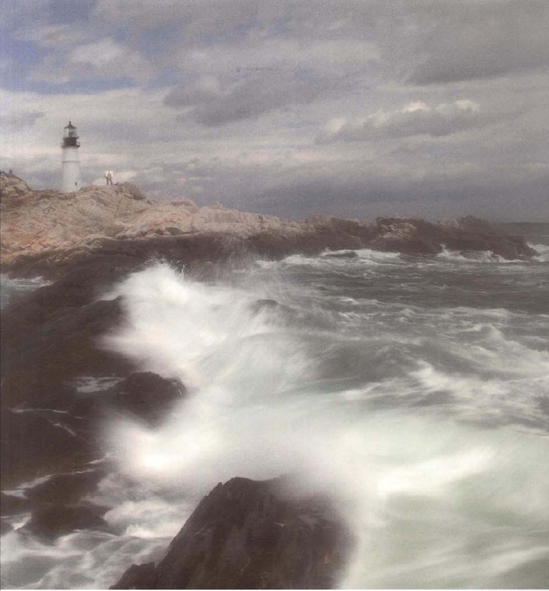
Climbing the steep steps, I paused and gasped for air. 1 was in Cusco, Peru, perched at 11,000 feet on a steep Andes mountainside. You might say the city was breathtaking. I was visiting my daughter who had just finished a couple of months of Spanish language school in Cusco; now we had plans to travel together in Peru and Bolivia. I'm in decent shape, but no match for thin air and steep streets.
Still, my first trip to South America delivered an amazing world. In Cusco, dogs and blue doorways popped up everywhere—as did strolling vendors besieging and beseeching me to buy postcards, fresh flowers, scarves, blankets, and trinkets. But most intriguing of all were the swarms of bicycle-powered contraptions clattering along the cobblestone streets.
Exposure at 1/6 second, f/9.

I awoke early on my second day and trolled the streets trying to catch some of these pedal-powered wagons as they flew by. Some pulled a small carriage—specifically designed for passengers. Others hauled a flat bed—clearly intended for cargo. A few seemed to handle both cargo and passengers.
It could be no easy task even for a native driver accustomed to the altitude to pull a passenger or two up the steep slopes. Perhaps the bicycle-equipped entrepreneurs only took them downhill and left the uphill strain for the motorcycle versions.
I began panning them using shutter speeds ranging from 1/4 to 1/60 second. Soon along came a young man pedaling and laughing with his passenger. His setup was reversed—rear engine power—he pushed a two-wheeled wagon in front of his bike. His passenger, a young boy, also laughed and often reached out to the driver.
I suspect the driver was delivering his child to school. As they laughed and chatted, 1 noticed each reach up a hand to exchange something. They were playing cards.
I snapped off a couple of shots and this is my favorite. What 1 like most about it is remembering their laughter as they swept by.
Exposure at 1/250 second, f/10.
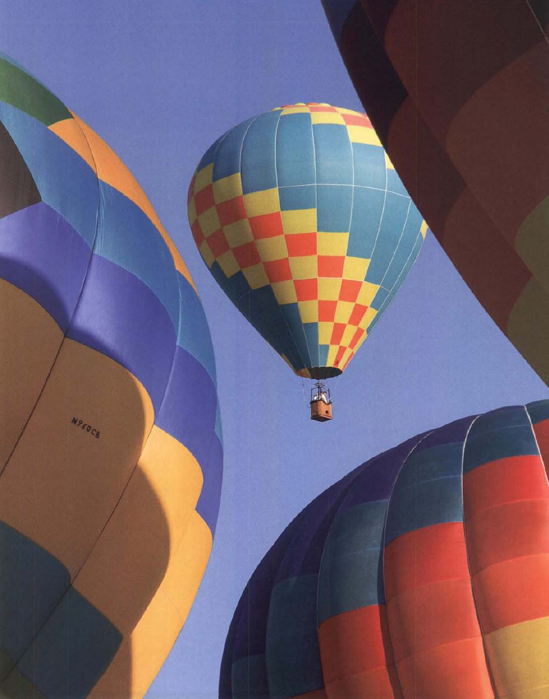
Although I've been photographing hot air balloons for many years, only when it came time to take a few shots for this book did I realize that somehow a slow-moving balloon can be harder to photograph than a motocross bike that shoots out of the woods, roars round a curve and—in a split second—disappears from view.
Although hot air balloons seem poky, they are big. Bigger than elephants. At a festival with twenty or more house-sized balloons inflated and inflating all around you, it's like you're wandering amongst a berd of lumbering elephants.
And then these elephants become airborne.
Hot air balloons launch only if the winds are under 10 mph, so stopping their action is no problem. Keeping up with it can be. (You quickly learn that something the size of a balloon can cover a lot more ground than you can.) And unlike motorized sports that run laps on a course where you can reliably predict where the action will occur, the movement of balloons seems random.
Add in a dozen or more balloons in different stages of launch and you face a constantly shifting visual arrangement. A balloon lifts into the air and for a split second it hangs in the background, framed by two foreground balloons still on the ground. But—because every balloon is in motion relative to all the others—this particular composition lasts for just an instant. Even if the background balloon remains stationary, slight breezes may tilt the balloons in the foreground left and right, randomly opening and closing the gap through which the background balloon so beautifully hangs.
As I was reviewing pictures for this and other chapters, 1 came across the one shown bere. If you're going through this book from front to back, you may have already seen a few more photos of wave runners and jet skiers recorded using the more conventional techniques of stop action and panning.
In fact, you may even wonder why I picked a photo that seems a bit too blurred. If that's what you're thinking I have to admit I agree with you. Or did.
What struck me as I was trying to pick out pictures that represent specific shutter speeds was how much I wanted to choose pictures that epitomized the techniques of stopping and panning action—photos that showed razor sharp detail of a rocket subject frozen in mid air or strong blur for a panned shot. After looking at the same few thousand photos over and over again, I started becoming bored with seeing the same type of picture again and again (these are all mine naturally).
That's when I began to see alternative approaches with a fresh eye.
I must have ignored or rejected this one twenty times. It's a shot that's softly blurred not by panning but by using a moderate shutter speed of 1/60 second. I did this deliberately. Now I like it. It conveys the intense bouncing and pounding a jet skier endures. Struggling to hold onto his craft, the rider skips across the surface only to be jolted to the joints when be smashes his machine through the wakes of other water craft. He teeters and twists precariously on turns and struggles to stay upright.
The lesson for me was not to become trapped in your own channels of likes and dislikes, but to remain open to new paths be they your own or somebody else's.
Exposure at 1/60 second, f/25.


